ubuntu12.04 opencv2.4.1编译自己的例子
来源:互联网 发布:asm算法 编辑:程序博客网 时间:2024/05/20 18:16
编译命令:
g++ -o test test.cpp `pkg-config opencv --cflags --libs`
若用:
g++ `pkg-config --cflags --libs opencv` -o test test.cpp
会出错:
/tmp/ccIHQrph.o: In function `main':
test.cpp:(.text+0x6c): undefined reference to `cv::imread(std::basic_string<char, std::char_traits<char>, std::allocator<char> > const&, int)'
test.cpp:(.text+0x10c): undefined reference to `cv::namedWindow(std::basic_string<char, std::char_traits<char>, std::allocator<char> > const&, int)'
test.cpp:(.text+0x13a): undefined reference to `cv::_InputArray::_InputArray(cv::Mat const&)'
安装过程:(转载)
http://www.samontab.com/web/2012/06/installing-opencv-2-4-1-ubuntu-12-04-lts/
The latest Long Term Support version of Ubuntu(12.04 LTS) is out and a new version of OpenCV was released as well. This means that now is a great opportunity to update my OpenCV installation guide to the latest versions, Ubuntu 12.04 LTS and OpenCV 2.4.1.
We are going to setup OpenCV to use the new Qt highgui interface, which is much better than the simple highgui interface. Also, we will install OpenCV with support for OpenGL, as well as reading and writing videos, access to a webcam, Python, C and C++ interfaces, and Intel Threading Building Blocks (TBB).
OK, so the first step is to make sure that everything in the system is updated and upgraded:
1sudo apt-get update2sudo apt-get upgradeNow, you need to install many dependencies, such as support for reading and writing image files, drawing on the screen, some needed tools, etc… This step is very easy, you only need to write the following command in the Terminal:
1sudo apt-getinstall build-essential libgtk2.0-dev libjpeg-dev libtiff4-dev libjasper-dev libopenexr-dev cmake python-dev python-numpy python-tk libtbb-dev libeigen2-dev yasm libfaac-dev libopencore-amrnb-dev libopencore-amrwb-dev libtheora-dev libvorbis-dev libxvidcore-dev libx264-dev libqt4-dev libqt4-opengl-dev sphinx-common texlive-latex-extra libv4l-dev libdc1394-22-dev libavcodec-dev libavformat-dev libswscale-devTime to get the OpenCV 2.4.1 source code:
1cd ~2wget http://downloads.sourceforge.net/project/opencvlibrary/opencv-unix/2.4.1/OpenCV-2.4.1.tar.bz23tar -xvf OpenCV-2.4.1.tar.bz24cd OpenCV-2.4.1Now we have to generate the Makefile by using cmake. In here we can define which parts of OpenCV we want to compile. Since we want to use Python, TBB, OpenGL, Qt, work with videos, etc, here is where we need to set that. Just execute the following line at the terminal to create the appropriate Makefile. Note that there are two dots at the end of the line, it is an argument for the cmake program and it means the parent directory (because we are inside the build directory, and we want to refer to the OpenCV directory, which is its parent).
1mkdir build2cd build3cmake -D WITH_TBB=ON -D BUILD_NEW_PYTHON_SUPPORT=ON -D WITH_V4L=ON -D INSTALL_C_EXAMPLES=ON -D INSTALL_PYTHON_EXAMPLES=ON -D BUILD_EXAMPLES=ON -D WITH_QT=ON -D WITH_OPENGL=ON ..Check that the above command produces no error and that in particular it reports FFMPEG as YES. If this is not the case you will not be able to read or write videos. Also, check that Python, TBB, OpenGL, V4L, OpenGL and Qt are detected.
If anything is wrong, go back, correct the errors by maybe installing extra packages and then run cmake again. You should see something similar to this:
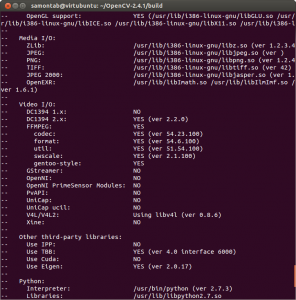
Now, you are ready to compile and install OpenCV 2.4.1:
1make2sudo makeinstallNow you have to configure OpenCV. First, open the opencv.conf file with the following code:
1sudo gedit /etc/ld.so.conf.d/opencv.confAdd the following line at the end of the file(it may be an empty file, that is ok) and then save it:
1/usr/local/lib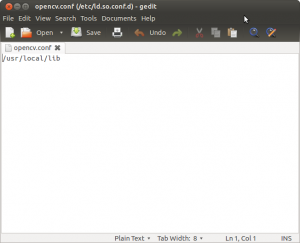
Run the following code to configure the library:
1sudo ldconfigNow you have to open another file:
1sudo gedit /etc/bash.bashrcAdd these two lines at the end of the file and save it:
1PKG_CONFIG_PATH=$PKG_CONFIG_PATH:/usr/local/lib/pkgconfig2export PKG_CONFIG_PATH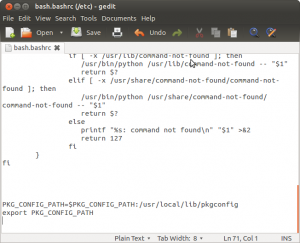
Finally, close the console and open a new one, restart the computer or logout and then login again. OpenCV will not work correctly until you do this.
Now you have OpenCV 2.4.1 installed in your computer with Python, TBB, OpenGL, video, and Qt support.
Check out the cool Qt interface which provides image viewing capabilities with zoom, as well as the ability to save the current image with just one click.
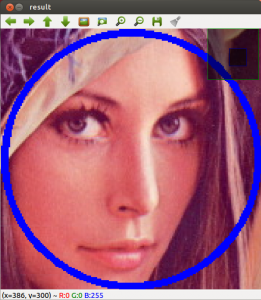
If you zoom in enough, you can see the RGB (or intensity) values for each pixel.
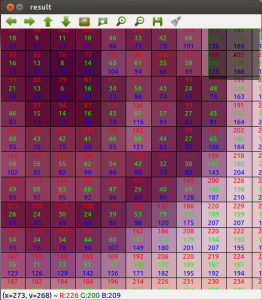
Now let’s build some samples included in OpenCV:
1cd ~/OpenCV-2.4.1/samples/c2chmod +x build_all.sh3./build_all.shNow we are ready to run the examples:
1./facedetect --cascade="/usr/local/share/OpenCV/haarcascades/haarcascade_frontalface_alt.xml"--scale=1.5 lena.jpg
1./facedetect --cascade="/usr/local/share/OpenCV/haarcascades/haarcascade_frontalface_alt.xml"--nested-cascade="/usr/local/share/OpenCV/haarcascades/haarcascade_eye.xml"--scale=1.5 lena.jpg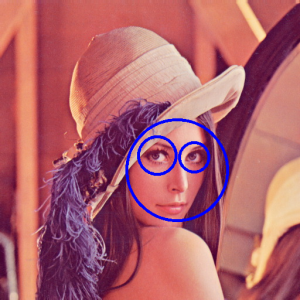
1~/OpenCV-2.4.1/build/bin/grabcut ~/OpenCV-2.4.1/samples/cpp/lena.jpg
1~/OpenCV-2.4.1/build/bin/calibration_artificial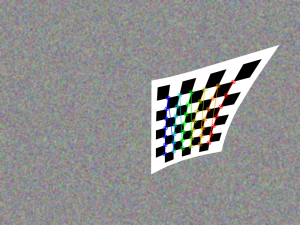
1python ~/OpenCV-2.4.1/samples/python2/turing.py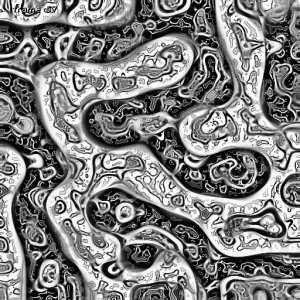
Posted in Image Processing, Programming.
- ubuntu12.04 opencv2.4.1编译自己的例子
- ubuntu12.04+qtcreator+opencv2.4.9的一个简单例子
- ubuntu12.04安装OpenCv2.4.1并编译测试
- ubuntu12.04安装opencv2.4.1
- ubuntu12.04安装opencv2.4.1
- MAC os下自己编译opencv源码得到opencv2.framework的简单使用例子
- ubuntu12.04安装opencv2.4.8,并运行简单例子
- Ubuntu12.04下OpenCV2.4.9源码编译安装
- ubuntu12.04编译安装opencv2.4.8过程记录
- ubuntu12.04配置qt4+opencv2.4.1环境
- ubuntu12.04+Opencv2.3.1
- ubuntu12.04安装openCV2.3.1/opencv2.4.2
- ubuntu12.04安装openCV2.4.2
- ubuntu12.04安装openCV2.4.2
- ubuntu12.04安装openCV2.4.2
- ubuntu12.04安装openCV2.4.2
- ubuntu12.04下的opencv2.3.1安装(更新)
- ubuntu12.04下opencv2.4.9的安装和使用
- VS2005的include,library,src等路径自动设置
- 俄网络犯罪地下市场:各式黑客服务明码标价
- 深入研究 C++中的 STL Deque 容器
- TinyXml使用总结
- IT行业的感悟
- ubuntu12.04 opencv2.4.1编译自己的例子
- Activiti之流程通过、驳回、会签、转办、中止、挂起等核心操作封装(Activiti5.9)
- 带索引的HIVE
- 归纳一下:C#线程同步的几种方法
- 《计算机语言C++》 MFC 内部连接和外部连接
- .带索引的mapReduce
- 浪潮之巅读后感
- 泛型
- 集合复习


